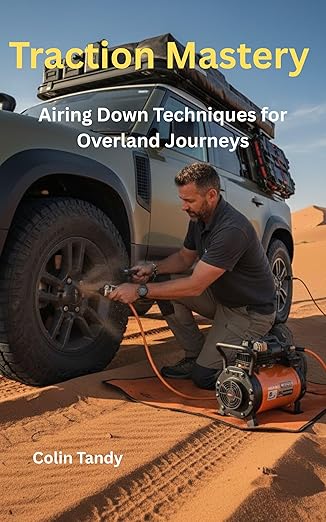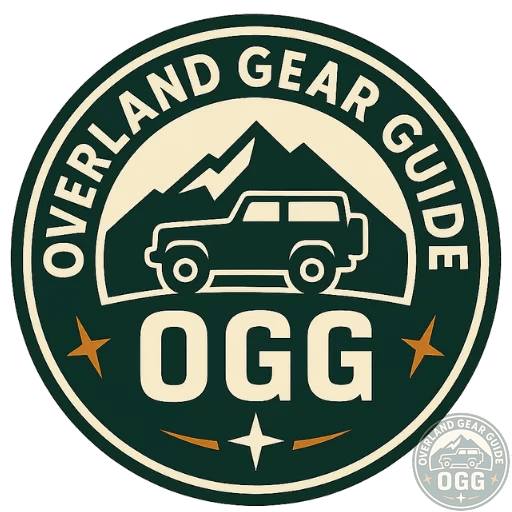Tyre Anatomy & Safe Pressure Guide for Overlanders

Tyre construction 101 (why it limits your PSI)
Each tyre is a flexible pressure vessel: tread for bite, a carcass with plies for strength, beads that lock to the wheel, and sidewalls that flex and protect. As PSI drops, more load shifts to the sidewall and bead retention is stressed — so construction matters.
Sidewalls and plies
Thicker, tougher sidewalls (common on LT-rated tyres) resist cuts and support lower pressures without folding. P-metric tyres use lighter construction for comfort and efficiency.
Beads and wheel fit
The bead’s steel bundle seals against the wheel seat. At very low PSI, lateral loads can unseat the bead — especially with mismatched wheel widths or sharp side loads.
Load index, speed rating, and LT vs P-metric
The sidewall code includes the load index (weight the tyre can carry at a rated pressure) and speed rating. LT tyres are tested differently and assume higher inflation for their stated loads.
| Type | What it means | Off-road implication |
|---|---|---|
| P-metric (e.g., 265/70R17 115T) | Passenger construction; comfort-biased; load index at lower pressure | Capable off-road but less tolerant at very low PSI; protect sidewalls |
| LT-metric (e.g., LT285/70R17 E) | Light-truck spec; stronger carcass; load index at higher pressure (often 80 PSI max) | Handles lower PSI better; heavier; more heat at speed — reinflate early |
Wheel width and safe lower limits
Tyre on too-wide a wheel = stretched beads and easier de-bead. Too narrow a wheel = more sidewall bulge and vague steering. Stay within the tyre maker’s approved wheel width range.
| Setup | Typical lower limit* | Notes |
|---|---|---|
| P-metric A/T on standard wheels | ~18–22 PSI | Brief, low-speed off-road only; avoid sharp lateral loads |
| LT (Load Range C/D) A/T | ~15–18 PSI | Balanced grip and protection on sand/rock |
| LT (Load Range E) A/T or M/T | ~12–16 PSI | Stout sidewalls; still go slow and avoid rim strikes |
| Beadlocks | ~6–10 PSI | Specialist setups; crawl speeds; check on-road legality |
*Conservative field guidelines for slow off-road use. Vehicle weight, tyre size, wheel width and terrain can shift the safe lower limit.
Heat, load and temperature
- Lower PSI increases flex and heat; keep speeds low off-road and reinflate for pavement.
- Cold mornings read 1–3 PSI lower; set baselines “cold”.
- Heavier rigs need higher PSI for the same margin; don’t copy a lighter build’s numbers.
Build your baseline in 10 minutes
- Set highway PSI from the vehicle placard (cold).
- Choose a test section and lower by 3–4 PSI.
- Drive 200–300 m; check steering feel, grip and bulge.
- Repeat in small steps until grip improves without excessive bulge or rim contact.
- Record your go-to pressures for sand/rock/snow; reinflate before any high-speed transit.
.png)
Helpful Tools for Accurate PSI
Two field-proven picks that make pressure management fast and accurate.
JACO ElitePro-X Tire Pressure Gauge (100 PSI) with Lightning Chuck

- Accuracy to ANSI B40.1 (±1.5%) — no batteries required.
- Push-to-lock chuck seals instantly; quick-release with zero air loss.
- Aircraft-grade body, 8" braided hose and fast bleeder valve.
Tyre Bead Sealer (Professional Grade)

- Helps reseat and seal stubborn beads after off-road de-beads.
- Brush-on application; compatible with most rim/tyre materials.
- Carry a small bottle in your air kit for emergencies.
Disclosure: Some links are affiliate links. If you buy through them, we may earn a small commission at no extra cost to you.
Looking to refine your setup? Explore our Air-Management Gear Guide for compressors, gauges, and valve tools trusted by overlanders.
📗 Traction Mastery: Airing Down Techniques for Overland Journeys

Unlock Your 4×4’s True Potential. The Most Powerful Upgrade Costs Nothing.
You have the rig and the route — now master the art of airing down. Go beyond guesswork with evidence-based techniques for sand, mud, rock, and snow.
- The science made simple: contact patch, flotation, mechanical grip.
- Terrain-specific blueprints with starting pressures and technique.
- The essential toolkit and step-by-step field procedures.
- How to avoid de-beads, rim damage, and sidewall failures.
Authored by overlanding expert Colin Tandy. Perfect for first-time explorers and seasoned travelers alike.

